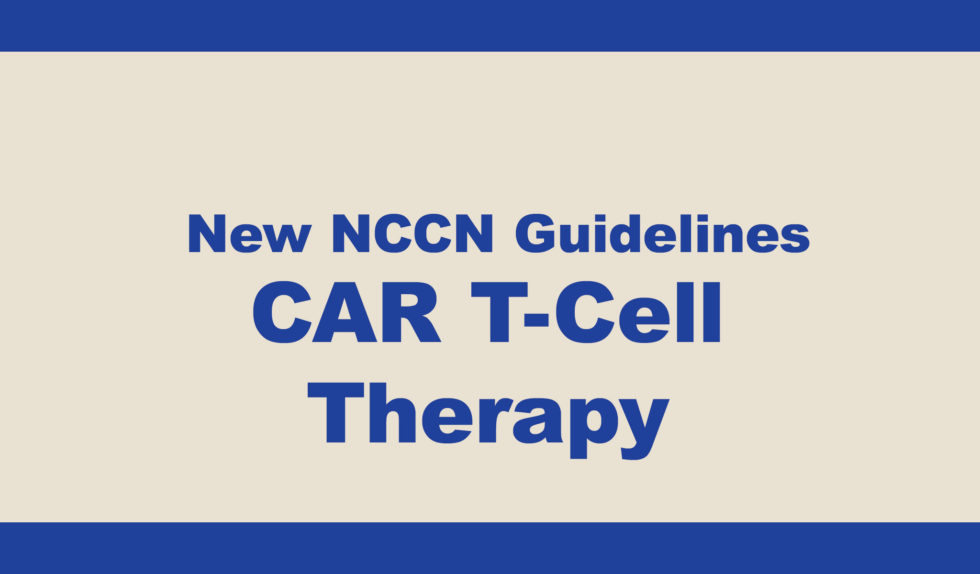CAR T-Cell Therapy:
What Cancer Survivors and Caregivers Need to Know
The emerging use of immunotherapy for treating cancer means different side effects than traditional treatments like chemotherapy. The National Comprehensive Cancer Network (NCCN) has recently published a new patient guideline on how to manage side effects from chimeric antigen receptor (CAR) T-cell therapy.
How Cancer Survivors and Caregivers Can Prepare for CAR T-Cell Therapy
The new NCCN Guidelines for Patients explain how to recognize and manage immunotherapy-related toxicities and help prepare patients for lengthy treatment duration. This new book helps people with cancer and their caregivers get a full understanding of what this type of treatment entails.
CAR T-cell therapy is new in that, unlike chemotherapy, it focuses on using qualities of the immune system to target cancer.
– Olalekan Oluwole, MD
“These guidelines explain, organize, and streamline a complex and rapidly evolving concept,” said Olalekan Oluwole, MD, Vanderbilt-Ingram Cancer Center, a member of the NCCN Guidelines Panel for Management of Immunotherapy-Related Toxicities. “Traditional chemotherapy treatment affects all cells, and often fails to completely eradicate cancer. It can also leave patients with long-term complications, including other forms of cancer.
“CAR T-cell therapy is new in that, unlike chemotherapy, it focuses on using qualities of the immune system to target cancer. The targeting is akin to a heat seeking missile that won’t stop until it takes out any cell with the target, leading to potential long-term or permanent remission. CAR T is given one time, unlike chemotherapy, which is given over multiple cycles and could go on for months or years. However, patients are often surprised to learn that the single CAR T infusion includes a 28-day monitoring period during which they need to stay in close proximity to their treatment center.”
Two Main Side Effects of CAR T-Cell Therapy
During that monitoring period, the health care team is primarily watching for two things: cytokine release syndrome (CRS)—in which immune cells affected by the treatment release proteins called cytokines into the blood, stimulating an intense systemic inflammatory response—and immune effector cell-associated neurotoxicity syndrome (ICANS)—a range of neurological side effects. Both CRS and ICANS are generally reversible if treated promptly.
“Before starting CAR T-cell therapy two years ago, my doctor warned me and my wife that it might be a wild rollercoaster ride for a month, but then I would have an excellent chance to be in a long remission,” said Brian Koffman, MDCM (retired), MSEd, Co-Founder, Executive VP, and Chief Medical Officer, CLL Society, Inc. “The NCCN Guidelines for Patients let people know CAR T-cell therapy is a powerful cell-based treatment capable of offering very durable responses in difficult to treat blood cancers, but in some cases the cancer killing can be so intense that the collateral damage may manifest as frightening symptoms. Fortunately, these adverse events tend to be predictable, manageable, and short-term. I told my doctor to ‘sign me up,’ and I would say that again today.”
The NCCN Guidelines for Patients let people know CAR T-cell therapy is a powerful cell-based treatment capable of offering very durable responses in difficult to treat blood cancers
– Brian Koffman, MDCM (retired), MSEd
“CRS can set in rapidly, pushing the patient’s body to very high temperatures and taking quite a toll,” cautioned Dr. Oluwole. “However, we researchers are learning more about how to collaborate to predict toxicities and sharing knowledge on recognizing and treating them more quickly. The new NCCN Guidelines for Patients are yet another example of how we’re sharing this important information.”
Improve the Likelihood of Successful Treatment
NCCN Guidelines for Patients are based on the NCCN Guidelines used by clinicians worldwide, which have been found to improve the likelihood of successful treatment and longer survival while also reducing costs, according to numerous independent studies. They cover every major type of cancer as well as prevention, supportive care, and specific patient populations.
The NCCN Guidelines represent the consensus of a multidisciplinary panel of experts for each cancer type or clinical scenario based on the latest evidence. The NCCN Guidelines for Patients put the clinical recommendations into easy-to-understand language alongside illustrations, suggested questions, and a glossary of terms and acronyms.
NCCN Guidelines for Patients are frequently-updated resources for cancer survivors and their loved ones. These guides are available for free online at NCCN.org/patients, or via the NCCN Patient Guides for Cancer App. Printed copies are available at Amazon.com for a nominal fee.
Source: National Comprehensive Cancer Network, nccn.org


